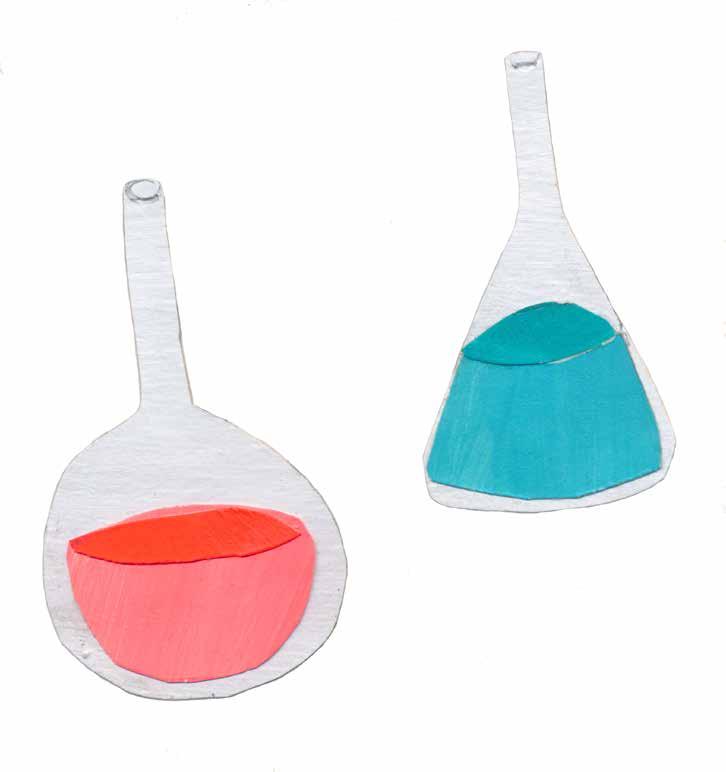

Seawater and Its Elements 10
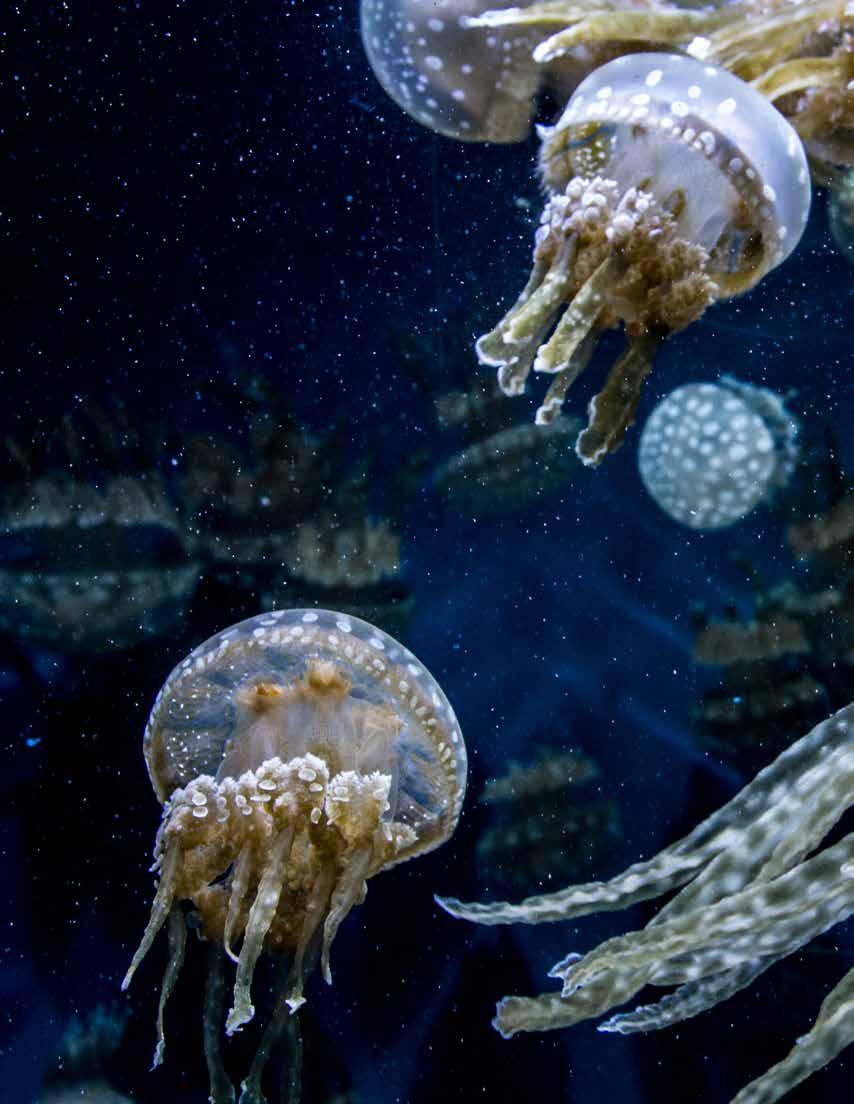
Figure 10.1
The spotted lagoon jelly (Mastigias papua) inhabits welllit lagoons and lakes where the symbiotic algae in its tissues may flourish. Though the jellies eat plankton, they also obtain energy from their symbionts. Their trophic flexibility enables them to survive in a variety of environmental conditions (Djeghri et al. 2021).
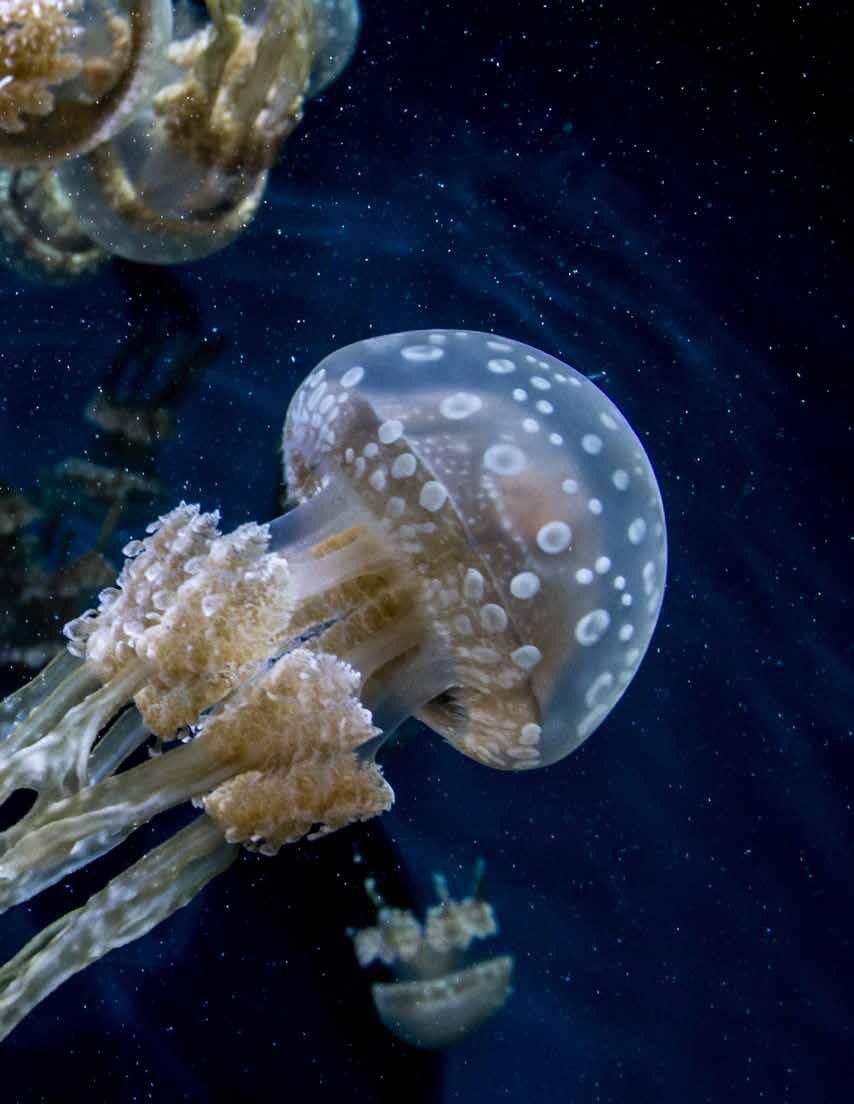
We now contemplate the very medium about which this book is written, the ocean. But what is the ocean? Is it the water contained within the ocean basins? What makes some water “ocean water” and other water “not ocean water”? Aren’t the waters of the ocean connected to the waters of the land? If so, isn’t the water in our bodies similarly connected? Does that make us a part of the ocean?
Water is mysterious, hypnotic, intoxicating, sensual. Encountering the ocean’s edge, we stretch our eyes to see its farthest reaches, to make out the silhouette of a sailboat or the drum of a passing ship. When we hear crashing waves or rushing rivers, or the sound of rainfall against the windowpane, we immediately recognize it. A walk along a beach with the regular swish and swash of the waves soothes our stress-laden nerves. And who doesn’t love sleeping in a warm, cozy bed to the sound of rain? Our noses take notice of the smell of a lake or the sea, pungent for some, a perfume for others. We simply can’t live without daily (or twice-daily) showers. Artists and writers and thinkers claim that some of their best ideas come while in the shower. And though for many, baths are a thing of the past, a dip in a lake, a dash into the ocean, or a dally in a sun-filled pool brings a kind of peace and serenity that’s hard to find in the dry parts of the world.
Figure 10.2
Water and the ocean hold philosophical and meditative charms.
American author Herman Melville (1819–1891) wrote, “Yes, as everyone knows, meditation and water are wedded forever.”

Credit: istock/NicoElNino
10.0 Introduction
Water is essential to all life, including humans. Humans—ancient and modern—have devised innumerable means to carry water with them: animal bladders, seashells, coconut shells, woven baskets, clay pots, metal canteens, glass containers, plastic bottles, bota bags, Camelbaks, and the trendy BPA-free reusable water bottle. In 2023 bottled water sales are expected to reach $342.4 billion worldwide (US dollars). In the US, we'll spend $94 billion (Statista.com).
It’s no surprise people prefer living near or spending time on the water. More than a third of Americans live in counties bordering the shoreline of an ocean, estuary, or Great Lake (NOAA 2013). The most popular travel destinations for Americans in 2017 (pre-pandemic) were beach vacations and cruises. A watery vacation holds philosophical and meditative charms. Chilean poet Pablo Neruda (1904–1973) wrote, “I need the sea because it teaches me.”
A study of the ocean connects us to the world of water in which we live. We are intimately connected to and dependent on the waters of the world, especially the ocean. But to properly understand the ocean, we must understand the physical and chemical nature of water itself. Our understanding of the water molecule provides a jumping-off point for understanding the world ocean and our planet. Let’s dive in!

Credit: istock/Erin Donalson
Figure 10.3
Immersed in water, we return to the experience of the womb, floating, timeless, living only in the present moment.
10.1 Anatomy of a Molecule
Figure 10.4
Coincidence? Or did Walt Disney know something about the shape of a water molecule?
If you could shrink yourself to a billion times smaller than you are now, a water molecule would be about the size of a footstool. Assuming you could get a water molecule to hold still (they like to jump around like little kids), you could determine that a single water molecule has a diameter of approximately 1.1 × 10–8 inches, or 280 picometers. (A pico is 10–12, or 0.000000000001). Stepping back from your tamed water molecule and giving it a look-over, you take a quick breath and cover your mouth: “OMG! It looks like Mickey Mouse.” Indeed, the water molecule—when depicted as the stick-and-ball model of a molecule—resembles Mickey Mouse’s head, big ears and all.
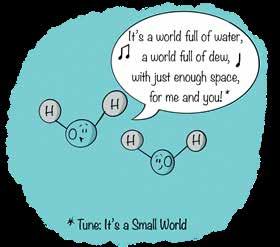
Credit: Shaw and Chamberlin
Figure 10.5
Early models of the solar system inspired the classic view of the structure of atoms.
The analogy offers an atomic view of water, too. Mickey’s head and ears represent different atoms, namely, oxygen and hydrogen. One molecule of water consists of one atom of oxygen—Mickey’s head—and two atoms of hydrogen—Mickey’s ears. But the structure of water was discovered long before Mickey. In 1805 French chemist Joseph Louis Gay-Lussac (1778–1850) and famed German biogeographer Alexander von Humboldt (1769–1859) suggested a 2:1 ratio
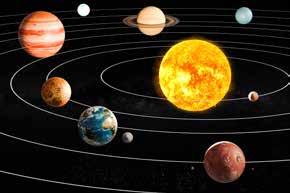
Credit: istock/AlexLMX
of hydrogen to oxygen (Scott 1887). But before we go any further with Mickey’s head and the structure of water, let’s do some quick basic training in chemistry.
10.1 Anatomy of a Molecule

Credit: Shaw and Chamberlin
Figure 10.6
The classic view of an atom, devised by physicists Neils Bohr (1885–1962) and Ernest Rutherford (1871–1937) in 1913, features a nucleus surrounded by electrons.
Molecules are composed of atoms, the building blocks of matter, the “stuff” of which the universe is made. Atoms consist of subatomic particles, the number of which determines an atom’s properties and classification. We often visualize atoms as miniature solar systems, where the center of the atom—the nucleus—corresponds to the sun. The electrons, which “orbit” the nucleus, correspond to the planets. The nucleus of an atom is made up of two subatomic particles: protons, subatomic particles with a positive charge, and neutrons, subatomic particles with a neutral charge—that is, no charge. The electrons have a negative charge equal to the proton’s charge, but with the opposite sign.
In the language of chemistry, atoms with the same number of protons represent an element By definition, elements cannot be broken apart by ordinary chemical
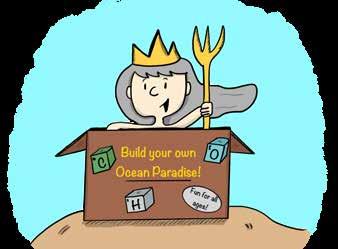
Shaw and Chamberlin
Figure 10.7
Elements represent the basic building blocks of all matter in the universe.
10.8
Au

reactions. On Earth there are 98 or so naturally occurring elements. These are the individual building blocks of all matter. We find these elements in the ocean, on land, and everywhere else in the universe. Each element—and, therefore, each atom of an element—is unique and has unique properties. Chemists represent elements with one or two letters— their chemical symbol. For example, the chemical symbol for hydrogen is H, and the chemical symbol for oxygen is O. Iron and silicon get twoletter chemical symbols, Fe and Si, respectively. Unknown or synthetic chemicals may receive temporary three-letter symbols (e.g., Chatt 1979).
Figure 10.9
One way to think of elements is to imagine a Lego set with 98 different varieties of plastic bricks, gears, Figures, and so forth. Elements are like the Lego set used to build Earth and the rest of the universe. It’s pretty mind-blowing if you think about it. Everywhere around you are atoms in various combinations that give shape and substance to you and the world around you. A selfie is nothing more than an image of the billions upon billions upon billions of atoms of which you are made (7 billion billion billion, or 7 × 1027, to be exact).
Your unique combination of carbon, hydrogen, and oxygen atoms is expressed in a selfie.

Interestingly, just three elements— carbon, hydrogen, and oxygen—make up 99 percent of those atoms of beautiful you.
10.2 The Periodic Table of the Elements
10.2 The Periodic Table of the
Elements
For convenience chemists organize elements into a chart known as the periodic table of elements, or simply the periodic table. Though different scientists prefer different arrangements of the periodic table—at least 1,000 different versions exist in the literature (e.g., Scerri 2013)—the purpose of the periodic table remains the same: to organize matter in a way that lets us quickly understand how it might behave in a chemical reaction.
Most commonly, elements are arranged according to their atomic structure and chemical properties. Rows of the periodic table correspond to energy levels of electrons. Columns represent elements with similar chemical behavior. We won’t delve into the details, but students with an interest in chemistry—or science in general—will find the periodic table and its variations useful and fascinating.
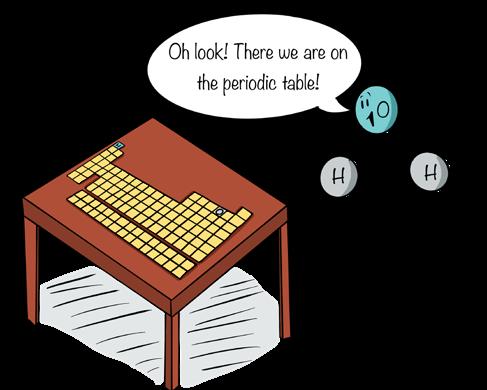
Credit: Shaw and Chamberlin
Figure 10.10
For convenience, chemists arrange elements by their common structures and properties. This arrangement helps chemists understand the behavior of different elements in chemical reactions.
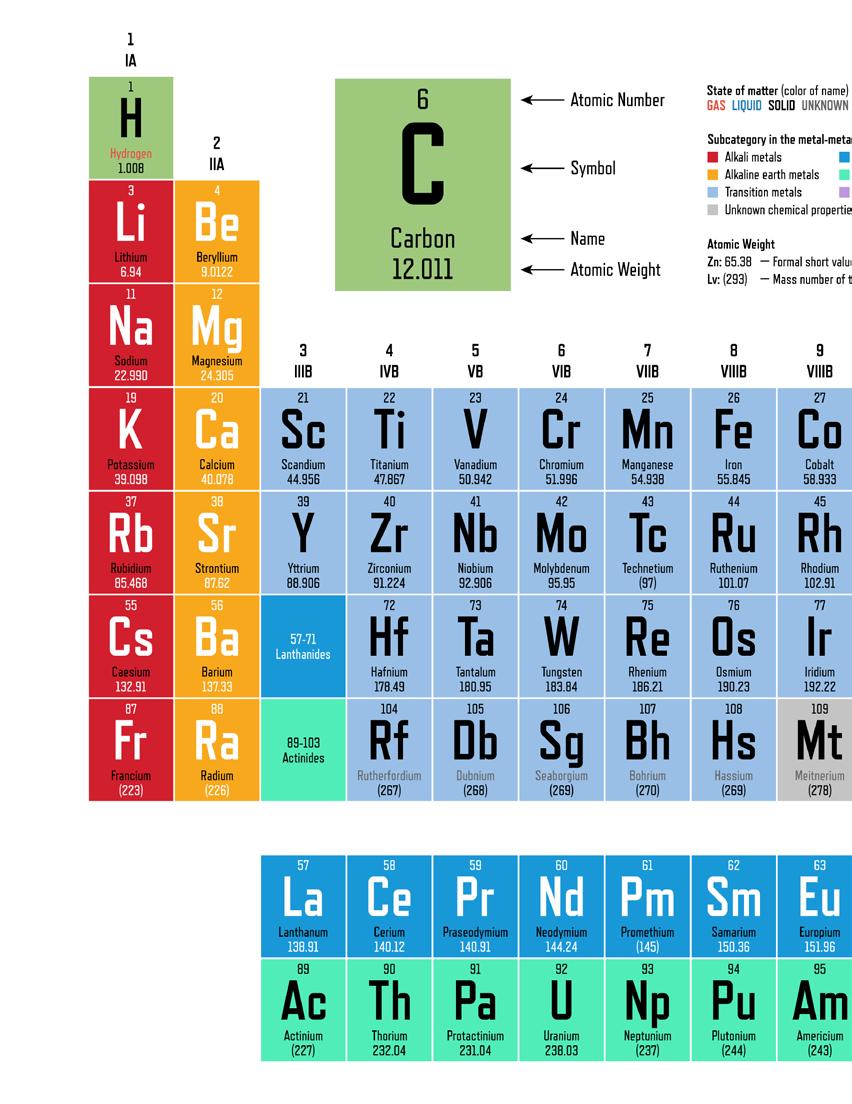
Figure 10.11
The periodic table of the elements provides a convenient way to quickly discover information about Earth's elements.
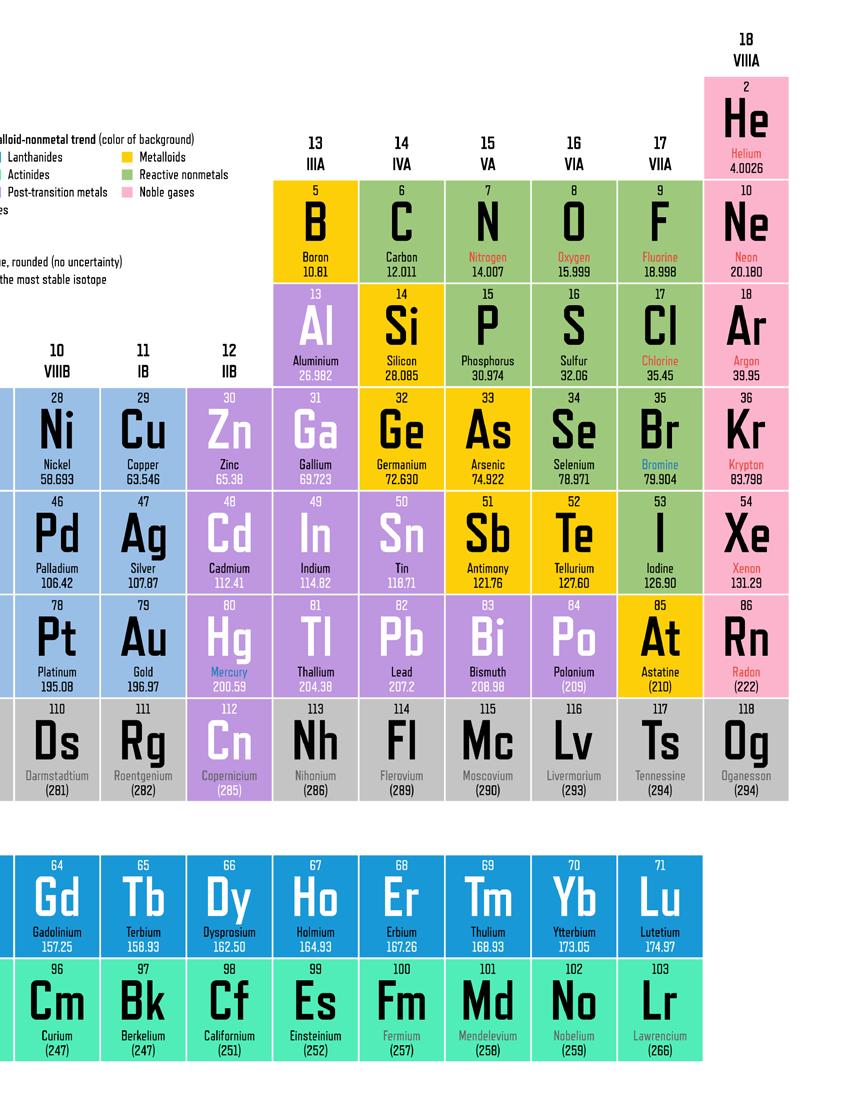
10.3 The Name’s Bond, Chemical Bond
The periodic table tells us something about how different elements react with each other. When two or more atoms combine, they form a bond. A bond is a kind of sharing between atoms that results in their connection. It’s like holding hands with someone you care about. You’re bonded. Like attractions between people, some chemical bonds are weak, some are strong, but most can be broken under natural conditions. Chemical bonding permits a coming together and coming apart of atoms. In fact, when one bond breaks, another almost always forms. The cool thing about these comings and goings of bonds is that energy is stored or released when bonds form or break, respectively. Organisms break and make chemical bonds as part of the biochemistry of staying alive. We won’t go into the particulars here, but remember that energy is an important part of the discussion of matter; the two go hand in hand. When two or more atoms bond to each other, a molecule is formed. Molecules may be composed of different atoms, such as carbon dioxide (CO2) or glucose, a simple sugar (C6H12O6). Molecules may also be
Figure 10.12
Like love, chemical bonds take many forms. The making and breaking of bonds—like relationships— involve energy.
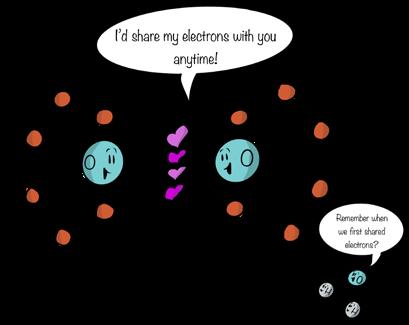
Credit: Shaw and Chamberlin
composed of the same atom, such as oxygen (O2) or nitrogen (N2). These homonuclear molecules are composed of identical atoms that bond to themselves. They are a type of diatomic molecule, meaning they occur in nature as doubles. Diatomic molecules may also be heteronuclear molecules, that is, made of different elements, such as carbon monoxide (CO). A few, such as ozone (O3), represent triatomic molecules
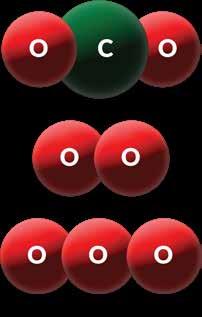
Credit: Chamberlin
And if all these terms weren’t enough, molecules composed of different atoms are called compounds. Compounds are composed of molecules that are composed of different kinds of atoms (i.e., different elements). So while water (H2O) is a compound, oxygen (O2) is not.
To simplify our discussion, I’ll use the word substance to refer to atoms, molecules, and compounds. Substance refers to all forms of matter with a definite composition. Substances include elements and compounds. You can write the chemical formula for a substance. However, a word of caution is required. The term substance does not include matter with an indefinite composition, such as a solution of something. For solutions chemists use the term mixture. A mixture consists of a collection of two or more atoms or molecules in varying proportions. Seawater is a mixture. The air that you breathe is a mixture. Mixtures can be formed without chemical bonding; there are no chemical reactions involved in their formation. The key point here is that there are different types of atoms, different ways that they hook up, and different ways that they mix. You know, like people.
Figure 10.14
Chemists classify matter in different ways. These terms make communication of chemistry more precise. Students of chemistry will want to be familiar with these terms.
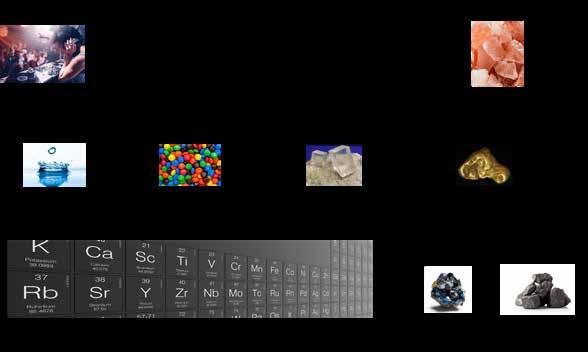
Credit: istock: (DJ) bernardbodo ; (pink salt) grafvision ; (drop) g-miner ; (halite) dgero (periodic table) Insomnela ; (M&Ms) Wikipeda/Evan-Amos ; (gold) Wikimedua/Natuur12 CC BY 2.0 ; (metals) Çağla Köhserli ; (non-metals) lusia83
10.4 Chemical Formulas
To represent the proportions of each type of atom in a molecule, chemists create chemical formulas. Chemical formulas include not only the chemical symbols for the elements but also the numbers of each atom in the molecule. The order of symbols obeys rules and conventions that don’t concern us here, but understanding how to read these chemical formulas is important. Conventionally, the number of atoms is represented as a subscript after the atom’s symbol. For example, the chemical formula O2 indicates two oxygen atoms. Unfortunately, this convention confuses the heck out of people. For example, water has two hydrogen atoms and one oxygen atom. As a chemical formula, we symbolize water as H2O. But your natural instinct (as one used to reading texts where numbers come before the noun they modify) is to think that the “2” refers to the O, leading you to erroneously conclude that
10.5 The Water Molecule
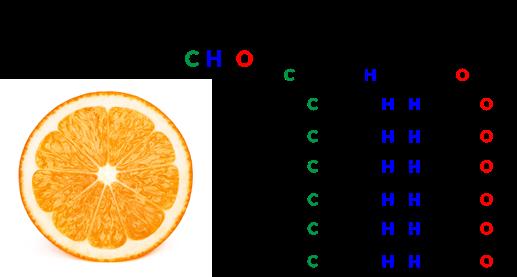
Credit: (orange) istock/vmenshov
Figure 10.15
Anatomy of a chemical formula. Subscripts refer to the number of atoms before the subscript.
water has two oxygen atoms. In the language of chemistry, the “2” refers to the H, meaning that water has two hydrogen atoms. Thus, water, symbolized as H2O, has two hydrogen atoms and one oxygen atom per molecule. If it helps, you have my permission to symbolize water as H-O-H, which is a lot more fun to say.
10.5 The Water Molecule
Writing water as H-O-H helps us visualize why water looks like Mickey Mouse. When the hydrogen and oxygen atoms come together as a water molecule—which they do because they are attracted to each other—they share their electrons in a covalent bond. Because oxygen is a larger atom with a bigger nucleus, it’s a bit more “powerful” than hydrogen, and, frankly, it hogs the electrons. Because electrons are negatively charged, being
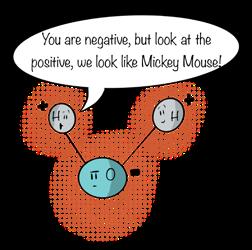
Figure 10.16
Polar molecules exhibit a separation of charges. Note the negative charge on the oxygen atom and the positive charges on the hydrogen atoms.
held closer to oxygen gives oxygen a slightly negative charge. We say that the oxygen atom in a water molecule is electronegative. Because the hydrogen atoms are stripped of some of their electron blanket, they become slightly positive, or electropositive. This separation of charges— the positive charge on the hydrogen atoms and the negative charge on the oxygen atoms—makes water a polar molecule, one that exhibits electropositive and electronegative ends. This property of the bonding of two hydrogen atoms and one oxygen atom gives water its characteristic V shape. When the atoms are represented as circles, the water molecule looks like Mickey Mouse.
10.5.1 Hydrogen Bonds, Cohesion, and Surface Tension
Water’s extraordinary ability to dissolve comes from its polarity. In the world of atoms, opposites attract. Positive charges attract negative charges, and vice versa. So it is with water. Because the oxygen atom of the water molecule is electronegative and the hydrogen atoms are electropositive, water molecules attract each other. In fact, the oxygen atom of one water molecule forms a bond with the hydrogen atom of another water molecule, a bond known as a hydrogen bond. This is not a strong bond—it’s a weaker covalent bond—but it’s strong enough to give
Figure 10.17
The electropositive oxygen atoms hook up with the electronegative hydrogen atoms and form a hydrogen bond.
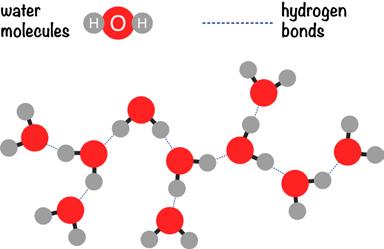
Credit: istock/ai_yoshi
water molecules some fascinating properties.
10.5 The Water Molecule
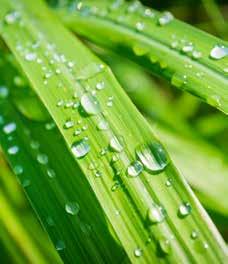
If you place a drop of water on a tabletop, what does it do? Rather than flattening out and running off the table like other liquids do, water beads up. Rain on a car hood will form beads of water. Dew on grass appears as beads of water. Beads of water pop out of your forehead when you sweat. The beading up of water comes about because of hydrogen bonds. It’s a property of the water molecule known as cohesion, the “sticking together” of molecules. Water is a sticky molecule; it likes to stick to other water molecules.
At the surface of a body of water, the stickiness of water gives rise to another property: surface tension—the enhancement of cohesion at the surface of a liquid. It’s this property that allows insects to skate across the top of a pond without falling in. A needle placed lengthwise on the top of a glass of water will remain afloat because of surface tension. The water molecules at the surface form stronger hydrogen bonds than the water molecules beneath them because there are no water molecules above them competing for their bonds. Think of it like being able to hold onto something with two hands
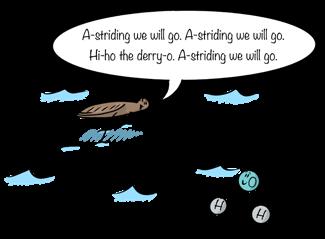
Water's surface tension provides enough strength to support organisms and objects.
instead of one—two hands are stronger. That’s how it is with surface water molecules. The result is a kind of “skin” on the surface of water in a glass, pond, lake, or ocean.
10.5.2 Water Is Dense
Another somewhat obvious property of water is that it weighs a lot. If you’ve ever lugged a five-gallon container of water, you know what I mean. A single gallon of water weighs eight pounds! The weight of water doesn’t come from the atoms that make it up; hydrogen is the lightest atom in the periodic table, and oxygen only has an atomic mass of 16. Compare that to the heaviest atom, uranium, at 238 atomic mass units. Where liquid water gets its weight is from its density. Density refers to the amount of matter packed into a given volume, or mass per unit volume. Liquid water is 800 times more dense than air. So there are a lot of water molecules packed into a liter of water compared to a liter of air, and that makes a bottle of water relatively heavy.
Most substances, especially gases, exhibit a change in density when their temperature changes or when they are subject to changes in pressure. Typically, an increase in temperature will reduce a substance’s density—its molecules spread apart—while a decrease in temperature increases its density—the molecules move closer together. Greater pressure increases density, while lower pressure reduces it.
Figure 10.20
Though false killer whales inhabit water, they don't mind stretching their fins in the much-less dense air above the ocean.
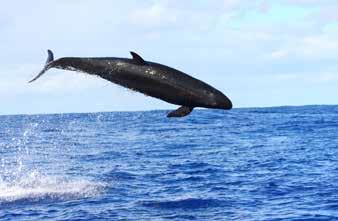
Credit: NOAA/Jim Cotton
Pure water, however, doesn’t quite obey the temperature rule. Pure water reaches its maximum density at about 39.2°F, or 4°C. Below 39.2°F, water
10.5 The Water Molecule
becomes less dense. The reason for this involves some complicated aspects of the behavior of water molecules. But you can think of it this way: like people, water molecules prefer a certain amount of personal space. Get too close, and they balk. “Get back,” they say. That limit of tolerance for closeness to other water molecules happens at about 39.2°F. But let’s be clear: this holds only for pure water. Seawater doesn’t exhibit this property.
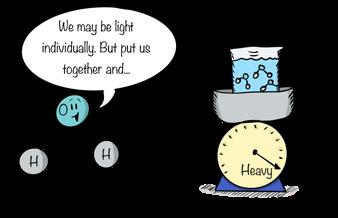
10.21
The close spacing of water molecules in liquid water make it dense and heavy to lug around.
Water, including seawater, also doesn’t obey the pressure rule. For the most part, water is incompressible, unable to be compressed. However, water can be compressed slightly, and this gives rise to some interesting changes in seawater’s temperature as pressure increases with depth. We’ll visit this topic in our chapter on deep circulation.
Water’s abundance on Earth makes it useful as a standard for comparing the density of other liquids, a quantity known as specific gravity. Scientists
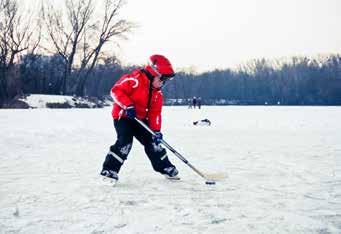
Figure 10.22
Ice, a solid, floats because it's less dense than liquid water. If ice didn't float, pond hockey might never have been invented.
Figure 10.23
Measurements of specific gravity prove useful for checking the alcohol content of beer and wine, as one example.
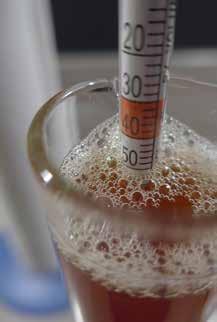
Credit: istock/ulcojan
define specific gravity as the density of a substance divided by the density of water. Thus, substances with a density greater than water will have a specific gravity greater than one, and substances with a density less than water will have a specific gravity less than one. See how that works? The density of water, and especially factors that change the density of seawater—namely, temperature and the saltiness of the seawater, its salinity—prove critical to understanding layering of the ocean and ocean circulation, as we shall see in later chapters.
10.6 What Are Salts?
For those of us who grew up near the ocean and spent many a day splashing around in it, the saltiness of its waters seems natural and barely merits our notice. But for those people who were raised far inland, who were perhaps already in their teens or adult years prior to even seeing the ocean for the first time, seawater, when tasted, serves up a rather rude welcome. The sting of that first swallow on the virgin tongue begets an immediate spit and a loud ugh. “It’s salty,” they exclaim, as if somehow their elementary school teacher was only kidding when she said the sea was made of salt. “Yes, my dear,” you can hear their teacher explaining on the student’s retelling of the horrific tale, “seawater contains salt. It won’t harm you.”
Salt is the general term applied to all the dissolved substances that we find in seawater. But the dissolved substance in the greatest
10.6 What Are Salts?

10.24
Do you remember your first experience with saltwater?
proportions in seawater has a familiar name and formula: sodium chloride (NaCl)—salt. As it turns out, seawater contains nearly all known natural elements in the periodic table—even gold. It’s said that if you could extract all the gold dissolved in the ocean—about 20 million tons— you would be a very rich person. Of course, what isn’t said is that the cost of extracting the gold using currently known chemical methods would exceed the amount you would make in selling it, or that if you put such a large quantity of gold on the market, the price per ounce would plummet. So don’t believe everything you read on the internet about gold in the ocean.
As solids, sodium and chlorine atoms stack up like a jungle gym, a playground structure made of crisscrossing metal pipes. They form a crystal lattice, the three-dimensional, symmetrical, and repetitive arrangement of atoms that forms a crystal. If you examine a sample of halite, a mineral formed from sodium chloride, you’ll notice regularly repeating cubes— the crystal lattice structure of sodium chloride. Diamonds also exhibit a crystal lattice
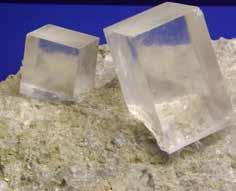
Credit: istock/dgero
10.25
A crystalline form of salt (NaCl) forms cubes called halite, such as the ones shown here.
Figure 10.26
At the molecular level, NaCl stacks up as a lattice of cubes, giving halite its characteristic cubical shape.
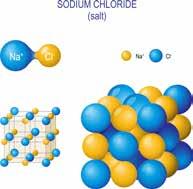
Credit: istock/ttsz
structure. In a crystal of salt, the sodium and chloride atoms have exchanged electrons; the sodium atoms have given up an electron to the chlorine atom, and the chlorine atom has accepted that electron. This kind of bond, where atoms exchange electrons, is called an ionic bond. The ionic form of sodium is referred to as the sodium ion while the ionic form of chlorine is called the chloride ion. It is one of the two major kinds of chemical bonds, the other being the aforementioned covalent bond formed when atoms share electrons.
10.6.1 Dissolved Salts
Figure 10.27
Ionic bonds form when atoms exchange electrons.
As we learned above, water is a polar molecule. Not only do the positive and negative charges on the water molecule make it ideal for bonding with itself, they also allow water to bond with a great number of other kinds of atoms and molecules. In fact, any polar molecule will dissolve in water because opposite charges attract and form bonds. Even complex molecules, including some normally “insoluble” hydrocarbons, are at least partially soluble owing to a charge on their molecule. Strictly nonpolar
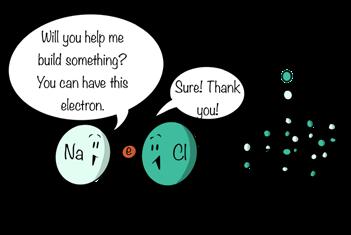
Credit: Shaw and Chamberlin
10.6 What Are Salts?
molecules—those with a balance of charges and no dipole—are, of course, insoluble. Thus, a mixture of water and a nonpolar molecule, such as olive oil, will not combine. You know the saying, “Oil and water don’t mix.” Now you can explain why.
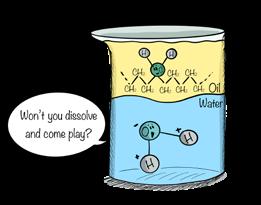
Shaw and Chamberlin
Figure 10.28
Oil, a nonpolar substance, won't dissolve in water.
So powerful is water’s ability to bond with other atoms and molecules that it has been named the universal solvent. A solvent is a substance that dissolves another substance. The substance being dissolved is known as a solute. When water acts as a solvent, the substance that it dissolves is the solute.
Now, I want to make sure that you understand what the word “dissolving” means. When you dissolve one thing in another, the thing being dissolved becomes part of the solution of the other. But what does that mean exactly?
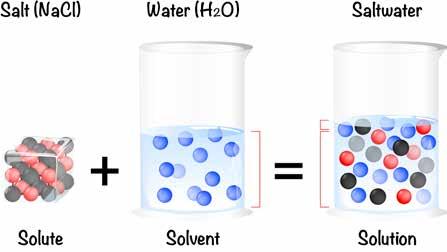
Credit: istock/ttsz
Figure 10.29
Salt, a solid solute, dissolves in water, a liquid solvent, and becomes part of a solution. The salt is no longer a solid.
Figure 10.30
When salt, or any soluble substance, dissolves in water, it becomes part of the matrix of the water. It is no longer a solid. It won't come out of solution or settle to the bottom unless conditions change.
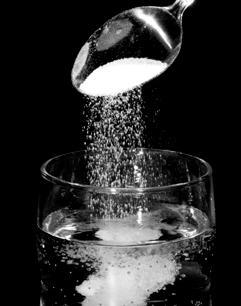
Credit: istock/ReggieLavoie
If you sprinkle a little bit of table salt in a bottle of water, the sodium and chlorine atoms in the salt become a few atoms among many molecules of water. In essence, they find a place to live within the spaces between the water molecules. They become part of a solution of water molecules and sodium and chlorine atoms. If you cap the bottle and keep it in a safe place for a hundred years and come back after that time and gaze upon that undisturbed, capped bottle of slightly salty water, where will you find the salt? You won’t. The salt will remain invisible because it is dissolved. It’s part of the matrix of the water. You will not—as many of my students erroneously answer
Figure 10.31
How does salt dissolve in water? The water attracts the individual ions more than they attract each other and the salt separates into Na+ and Cl- ions
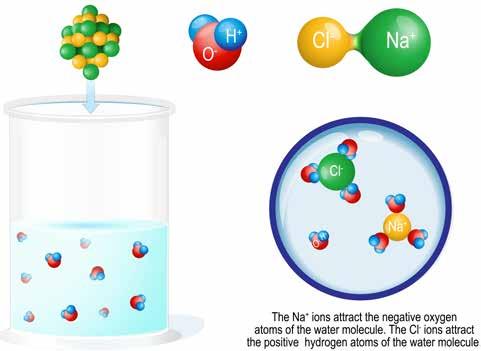
Credit: istock/ttsz
10.6 What Are Salts?
when first asked—“find it at the bottom of the bottle.” The salts stay dissolved. As long as conditions inside the bottle remain unchanged (i.e., as long as we don’t freeze or evaporate the water), the salt will remain permanently dissolved, held in solution by water.

Credit: Wikipedia
Figure 10.32
French physicist and chemist Joseph Gay-Lussac invented the word "salinity" and performed some interesting experiments involving salts.
Now, in defense of those students who thought that the salt would be found at the bottom of the bottle, they did have one thing correct: Gravity acts on solutions. While the salts do not come out of solution—they do not turn into solids again—they can be very slightly concentrated in their dissolved form at the bottom of a column.
In the early 1800s, Gay-Lussac wondered something similar: Can the gravity-driven settling of salts explain the higher salinities in the deep ocean? He performed an experiment with six-foot-tall glass tubes in which he placed a salt solution for several months. At the end of that time, he measured the salinity at the top and the bottom of the tubes. He found no difference (e.g., Wallace 1974).
Nonetheless, calculations made by chemical oceanographer Ricardo Pytkowicz (1929–1991) indicate that had Gay-Lussac extended the experiment for years, and had he been able to measure salinity to an accuracy of thousandths, he would have found a salinity of about 34.994 parts per thousand (ppt) at the top and 35.006 ppt at the bottom, assuming a starting salinity of 35.000 ppt (Pytkowicz 1962). The salts remain dissolved, of course, but they do concentrate ever so slightly under the force of gravity as long as the water remains undisturbed. A minor point, perhaps, but one that illustrates how scientists do their best to think of every possibility.
10.6.2 Anions and Cations
When sodium chloride comes into contact with water, the ionic bonds between the sodium and chlorine atoms disappear. The atoms in the salts separate—dissociate—from one another. That’s because the polar water molecules have a stronger attraction for the sodium and chlorine atoms than the two elements have for each other. With the ionic bond gone, the sodium atom takes on a positive charge, and the chloride atom takes on a negative charge. They become what are known as ions—atoms or molecules whose number of positively charged protons differs from their number of negatively charged electrons.
Ions by definition have a net electrical charge—the sum of their positive charges and negative charges does not equal zero. Ions with a negative charge, such as chloride, are called anions, while ions with a positive charge, such as sodium, are called cations. In the written language of chemistry, the ionic form of an atom or molecule is represented by a superscript of + or − following the chemical formula. For example, the sodium ion is represented as Na+ and the chloride ion is represented as Cl–. For cations and anions that have two or more positive or negative charges, respectively, the appropriate number is placed before the + or – sign, as in sulfate, SO42– or magnesium, Mg2+.
Figure 10.33
A simple word association can help you remember the charge on anions (a negative) and cations (cats have pos).
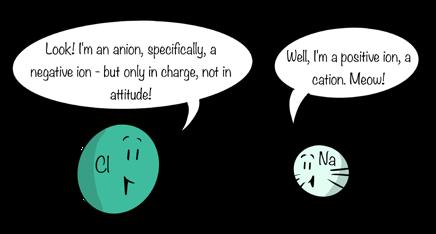
Credit: Shaw and Chamberlin
10.6 What Are Salts?
When salt dissolves in water, the electropositive hydrogen atoms of the water molecules surround the electronegative chloride ion, and the electronegative oxygen atoms of the water molecule surround the sodium ion. The sodium and chloride ions, in essence, become part of the fluid. As long as conditions remain constant, the sodium ions and chloride ions remain dissolved in solution.
10.6.3 States of Saturation
One final set of definitions completes our discussion of the dissolving power of water. The maximum concentration of a solute, including gases, that can be dissolved by a solution under a given set of conditions is called the saturation concentration. Two other states are possible: A solution may be undersaturated with respect to the solute, meaning the solution contains less of a substance than the saturation concentration; or the solution may be supersaturated, meaning the solution contains more of a substance than the saturation concentration.
Of course, the saturation concentration is not fixed; environmental factors such as temperature and pressure can change it. For example, at higher temperatures, the saturation concentration of salts in water increases. That is, water dissolves more salts at higher temperatures. Conversely, lowering the temperature reduces the saturation
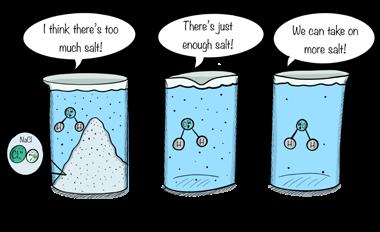
Figure 10.34 Three states of saturation.
solution.

Credit: Chamberlin ; istock/bhofack2
concentration. Thus, increases or decreases in temperature can cause a body of water to become undersaturated or supersaturated, respectively. States of undersaturation and supersaturation prove important to understanding dissolved gases in the ocean, too. However, gases behave differently in solution than do solids, as we shall see.
10.6.4 Electrostriction
As further testament to the magic of seawater, a curious thing happens when you dissolve NaCl in it: the volume of the solution decreases by about 3 percent (e.g., Pilson 2013). The reduction in volume of a solution when salts are added is called electrostriction, from electrical constriction. This reduction in volume results from the rearrangement of water molecules around solutes: positive hydrogens orient toward anions and the negative oxygen skews toward cations. In short, water and salts rearrange themselves into a tighter, more intimate space. Other salts cause electrostriction too. This property may help explain why seawater lacks the density maximum at 39.2°F of pure water (e.g., Pilson 2013).
10.6 What Are Salts?
10.6.5 The Periodic Table of the Ocean Elements
We can now examine the cast of characters—the elements—found in seawater. In 1997 Japanese oceanographer Yoshiyuki Nozaki (1947–2003) published an interesting electronic variation on the periodic table, one that included illustrations of the distribution of the elements in the water column. Nozaki’s work inspired researchers at the Monterey Bay Aquarium Research Institute to produce an online version, which they called the Periodic Table of the Elements in the Ocean (PTEO). The PTEO provides a fun and useful visual tool for studying the ocean elements.

Credit: istock/Edgar Joel Ipanaque Maza
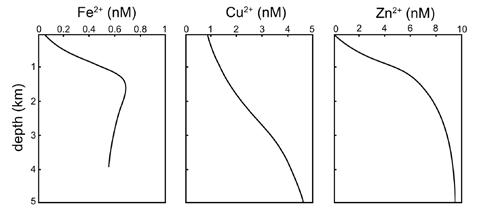
Credit: Wikipedia/Ssilverman00 CC BY-SA 4.0
Figure 10.36 Nearly all the elements found in the periodic table can be found dissolved in seawater.
Figure 10.37
Vertical profiles of seawater elements can be found in the Periodic Table of Elements in the Ocean.
10.7 Seawater Constituents
For this section, you may want to download a black-and-white periodic table or refer to the periodic table above. It helps to mark—and even color code—the following major categories of chemical constituents in seawater:
• Major constituents, the elements whose concentrations exceed 1 part per million in seawater
• The trace elements, or minor constituents, elements whose concentrations in seawater are less than 1 part per million, including elements that are important in biological reactions, the so-called biologically important nutrients
• Dissolved organic matter (DOM), a heterogeneous group of very dilute, dissolved carbon–containing substances, and particulate organic matter (POM), living and dead particles of organic matter
• Dissolved gases, gas-phase elements in seawater
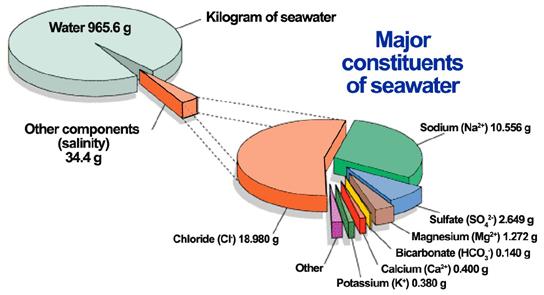
Credit: NASA
10.7 Seawater Constituents
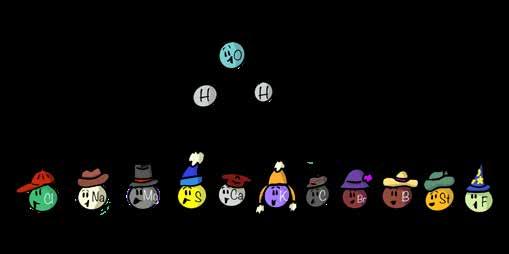
Credit: Shaw and Chamberlin
10.7.1 The Major Constituents
The major constituents comprise a group of 11 elements that make up 99.9 percent (by weight) of all the elements dissolved in seawater. Put another way, if you evaporate all the water from seawater so all that remains is salt, 99.9 percent of that salt will be composed of these 11 elements.
In order of decreasing concentration, we find chlorine, sodium, magnesium, sulfur, calcium, potassium, carbon, bromine, boron, strontium, and fluorine. Of course, seawater is mostly water, so don’t be misled. The dissolved salts make up only a small fraction of the total weight and volume of seawater, about 3.5 percent.
The 11 major constituents of
Perhaps most remarkably, these major constituents (except carbon) occur in identical proportions throughout the ocean, even though salinity may vary. Establishment of the Principle of Constant Proportions, as the relationship between major constituents is known, marked a key advance in chemical oceanography.
While a number of chemists worked on aspects of seawater chemistry from the late 1600s to the mid-1800s, three men in particular set in motion discoveries that would establish the foundations of chemical oceanography: Alexander Marcet (1770–1822), a Swiss-born chemist and
Figure 10.40
Dittmar's work aboard the HMS Challenger built upon Marcet's and Forchhammer's to verify the constant proportions of major constituents.
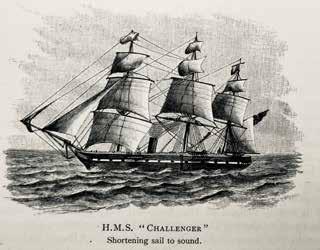
physician; Georg Forchhammer (1794–1865), a chemist and geologist from Denmark; and William Dittmar (1833–1894), a German-born chemist who worked in Scotland. These men contributed techniques, sampling approaches, principles, and terminology that remain in use today. (See Wallace 1974—followed here—for extensive details of their contributions.)
Marcet (in 1819) was the first to suggest that seawater from different parts of the Atlantic Ocean and the Mediterranean Sea “contained the same ingredients” and in “very nearly the same proportions to each other,” regardless of their salinity. In 1843 Forchhammer received several samples of Mediterranean seawater from a friend and set out to refine the methods of analysis. His painstaking work was summarized in a single publication, On the Composition of Sea-water in the different parts of the Ocean (Forchhammer 1865). Dittmar (1884) built on Forchhammer’s findings in his work on samples collected during the Challenger
Figure 10.41
The major constituents maintain the same proportions in all salinities.

10.7 Seawater Constituents
Expedition. Dittmar’s findings mirrored Forchhammer’s, with several important improvements. He adopted Forchhammer’s term “salinity” to describe total dissolved salts but modified it to the “parts of total salt in 1000 parts of sea water.” Here he established a commonly used unit for salinity—parts per thousand. He confirmed that six elements comprised the greatest percentage of salts, and that those salts occurred in constant proportions in all depths of all oceans. Dittmar’s result firmly established the Principle of Constant Proportions as a useful assumption when analyzing seawater.
The benefit of this principle comes when applied to the chemical analysis of seawater. If you know the concentration of just one of the major constituents, you know the concentrations of all of them (except carbon). Consider, for example, the color distribution of M&Ms (a very popular topic among math folks on the internet). According to StatsMedic (2023), M&Ms are produced in the following proportions: Brown (12.4%), Red (13.1%), Yellow (13.5%), Green (19.8%), Orange (20.5%), and Blue (20.7%). So if you had a bowl of M&Ms and wanted to know how many blue M&Ms were in the bowl, what might you do? Well, according to the Principle of Constant Proportions of M&Ms, you could count the number of brown M&Ms (the smallest number) to calculate the total number of M&Ms because
(Total brown M&Ms) ⁄ 0.124 = Total number of M&Ms (Eq. 10.1)
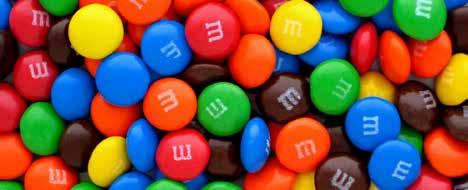
Credit: Wikipeda/Evan-Amos
Figure 10.42 M&Ms obey their own principle of constant proportions.
Figure 10.43
Conservative elements maintain constant ratios. Major constituents and some minor ones are conservative elements.
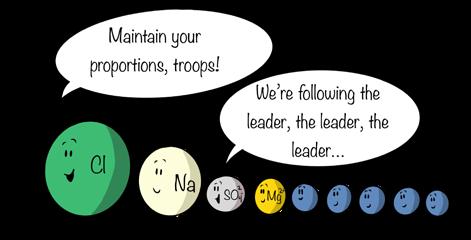
Credit:
Shaw and Chamberlin
Once you know the total number of M&Ms, you only need multiply by the percentages to calculate the number of each color. It’s much simpler and much faster, which is why the Principle of Constant Proportions made such a splash with marine chemists. Determination of the salinity of a sample could be based on analysis of a single constituent. And it could be accomplished in hours instead of days. Because nine other major constituents (except carbon) occur in a constant ratio—regardless of the salinity—major constituents are considered conservative elements; their ratios are conserved at all salinities. Most of the next group of elements, the minor constituents, obey no such rules.
10.7.2 The Trace Elements
Pilson (2013) confesses that a great deal of time and material effort is required to achieve reliable results for some of the important [trace] elements . . . that are present at very low concentrations in the central water masses of the oceans. The real concentrations are so vanishingly small that the quantities present are easily swamped by contamination.
Thus, we remain uncertain about the source–sink pathways of many of the minor constituents. Nevertheless, we can make some useful generalizations.
10.7 Seawater Constituents

Credit: Wikipedia/George Chernilevsky
The minor constituents—elements whose concentrations are less than 1 part per million in the ocean— include elements too dilute to be considered major. Pilson (2013) lists some 63 minor constituents and their concentrations, excluding gases and radioactive compounds. An element’s designation as “minor” should not mislead you. A good number of these elements prove vital to living things, and many trace the motions of water masses and other useful oceanographic processes. What unites them primarily are their low to extremely low concentrations in seawater.
Figure 10.44
The blood of the warty crab (Eriphia verrucosa) contains copper, a minor constituent that helps the crab fight infections.
Like major constituents, minor constituents originate from riverine, atmospheric, and subseafloor processes (Chapter 11). And like major constituents, their concentration and distribution in the ocean depend on the nature of their sources and sinks. For the most part, however, chemical oceanographers categorize minor constituents according to processes that remove them. On that basis the minor constituents can be divided into five types based on their vertical distribution in the water column (following Bruland and Lohan 2006).
10.7.2.1 Conservative-Type
Just like major constituents, some minor constituents exhibit conservative-type distributions; that is, their concentration in seawater varies proportionally with salinity. Metals such as cesium (Ce+) and rubidium (Rb+) exist as unreactive cations that spend a great deal of time in the ocean, 300,000 and 3 million years, respectively. Others, such as molybdenum and tungsten, play key roles in biological processes, but
their high concentrations relative to their use by organisms make their concentrations largely invariable. Less than a dozen minor constituents are included in this category.
10.7.2.2 Scavenged-Type
As noted by Jeandel et al. (2015), “particles act as an essential regulator of ocean chemistry because they determine the residence time of many dissolved elements in seawater.” Particles prove especially important for the removal of trace elements from the ocean. Jeandel and colleagues broadly distinguish two types of particles in the ocean: (1) external particles—those delivered via rivers, the atmosphere, the seafloor (shelf currents and hydrothermal vents), and even outer space (e.g., micrometeorites); and (2) internal particles, those formed within the water column via biological activities, aggregation of organic matter, or chemical precipitation. Dissolved trace elements interact with particles of both types, but here we focus on the removal of dissolved trace elements by sinking particles, a process called scavenging.
Scavenged elements easily attach to sinking particles, a process called adsorption. The attraction of trace elements to particles involves physical forces, or physisorption—the same weak forces that allow a gecko to
Figure 10.45
The ocean is a mixture of particles from external sources (atmosphere, rivers, seafloor, outer space) and particles formed internally by organisms.
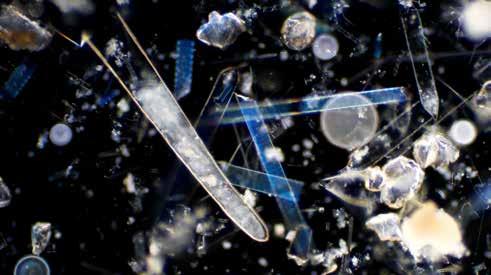
Credit: istock/tonaquatic
10.7 Seawater Constituents
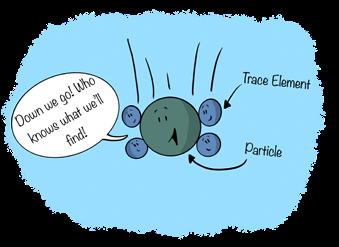
Shaw and Chamberlin
climb a wall. It also involves chemical forces, or chemisorption, which pertains to chemical bonding between atoms and the surface of particles. Chemisorption occurs, for example, in the removal of harmful substances in water (or air) by activated carbon filters. Note that adsorption—the sticking to or adherence of dissolved elements to particles—differs from absorption, in which the dissolved elements become part of the particle. It’s kind of like the difference between hanging on to the outside of a cable car in San Francisco (adsorption) or getting inside it (absorption). It’s not a perfect simile, but you get the idea.

Figure 10.46
Sinking particles "scavenge" trace elements as they sink.
Figure 10.47
People, like particles, may "adsorb" to the outside of a San Francisco cable car, or be "absorbed" inside it.
Figure 10.48
Aggregation makes particles sink faster. Aggregates may disintegrate, too, slowing their sinking rate.

Credit: Shaw and Chamberlin
Particles stick together, too, a process called aggregation. Thus, scavenging of trace elements by particles in the ocean is a three-part process: (1) adsorption of an element onto a particle; (2) aggregation; and (3) sinking of the particle to the seafloor.
Bruland and Lohan (2006) note that scavenged-type trace metals tend to occur in their greatest concentrations near their sources: the atmosphere, rivers, vents, or sediments. Aluminum, for example, shows its highest concentrations in the Atlantic Ocean and Mediterranean Sea due to a high input of atmospheric dust in these regions. Scavenged-type elements show their greatest depletion in older waters—those with less frequent atmospheric interaction. In the Pacific Ocean, for example, deep water remains out of contact with the atmosphere for hundreds of years, so scavenging can take place over a longer period of time. Pilson (2013) lists three dozen scavenged and “surface-depleted” minor constituents. However, he cautions that any of a number of geological or biological causes may generate a vertical distribution for a given constituent. As he puts it, “There is certainly much more to learn, and one wonders if there are more real surprises yet waiting.”
10.7.2.3 Hybrid-Type
Hybrid-type trace elements occur where a minor constituent participates in more than one pathway in its removal from seawater. Iron, for example, may exhibit surface minima—where it is strongly utilized
10.7 Seawater Constituents
by phytoplankton (a nutrienttype distribution)—or surface maxima—where low phytoplankton activity and significant atmospheric deposition elevate its concentrations. In deep waters, iron concentrations tend to remain constant, unlike other nutrients. Variations in dissolved iron in the ocean appear to represent a balance of recycling of organic matter, which releases iron, and scavenging of iron by particles, which removes it.
10.7.2.4 Mixed-Type

Credit: Wikimedia/SSilverman00 CC BY-SA 4.0
Figure 10.49
The hybrid-type vertical distribution of iron in the water column.
Some elements exist in multiple forms in the ocean, a chemical process known as speciation. Germanium (the element, not the flower, which is spelled geranium) takes a form very much like dissolved silica; it forms a compound called germanic acid (H4GeO4). But it also binds with methyl groups (CH3) to form what chemical oceanographers call the “Teflon of the sea,” mono- and dimethylgermanium—CH3Ge(OH)3 and (CH3)2Ge(OH)2, respectively. As germanic acid, germanium acts like a nutrient. It may be absorbed by phytoplankton and other plankton that form “shells.” As methylated germanium, however, it’s very stable, like a conservative minor constituent. Thus, the same element exhibits a mixed-type distribution, one that depends on the form of the element.
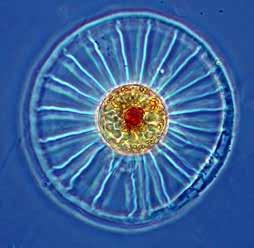
Credit: NOAA/John Dolan CC BY 2.0
Figure 10.50
Phytoplankton, such as the wagon wheel diatom, Planktoniella sol, use germanium as a nutrient (Sutton et al. 2010).
10.7.2.5 Biologically Important Nutrients
Biologically important nutrients, or simply nutrients, represent a group of dissolved substances necessary for the growth of photoautotrophs— photosynthetic organisms, such as phytoplankton, seaweeds, marine plants, and terrestrial plants. When oceanographers talk about nutrients, they aren’t talking about the stuff that comes in a box of Wheaties or even the kind referred to by nutritionists. An oceanographer’s nutrients are the dissolved stuff phytoplankton (and other photoautotrophs) absorb across their cell walls. Let’s get this straight: they do not “eat” nutrients like Pac-
People eat dots; they absorb them.
As many as 28 different nutrients may be required by phytoplankton (e.g., Moore et al. 2013; Supplemental). Elements required in greater quantities are generally referred to as macronutrients, while those needed in smaller amounts are called micronutrients. Reynolds
Figure 10.51
Whether certain elements are required in "large" quantities (i.e., macronutrients) or "trace" quantities (i.e., micronutrients) depends on the species and type of phytoplankton.
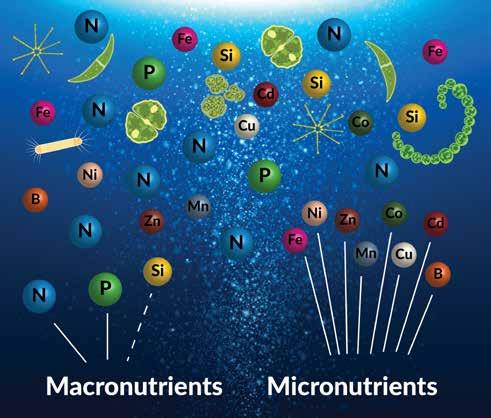
10.7 Seawater Constituents
(2006) defines macronutrients as those that exist at an abundance of greater than or equal to 1 percent of the ash-free dry mass of a cell. By this definition macronutrients include carbon (C), oxygen (O), hydrogen (H), nitrogen (N), phosphorus (P), and sulfur (S). Other authors, however, restrict the definition of macronutrients to those abundant elements that may limit the biomass of phytoplankton in the ocean, namely, phosphorus and nitrogen (e.g., Jones 2011). To this list some add silicon (e.g., Falkowski et al. 1998). Silica (SiO2) is required for the growth of diatoms—who use it to manufacture their cell walls. Surprisingly cyanobacteria also take up silica, as recently discovered by Baines et al. (2012). The accumulation of silica by cyanobacteria has major implications for the global silicon cycle (Ikeda 2021).
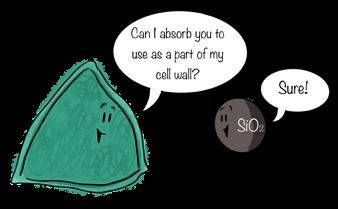
Shaw and Chamberlin
Figure 10.52
Some phytoplankton, especially diatoms, require silica to grow. Others don't use silica at all.
Micronutrients include several trace metals, such as iron (Fe), manganese (Mn), cobalt (Co), nickel (Ni), copper (Cu), zinc (Zn), cadmium (Cd), and boron (B), among others (e.g., Carrano et al. 2009; Twining and Baines 2013). Iron has received a lot of attention in recent decades for its role in limiting the biomass of phytoplankton in regions of the
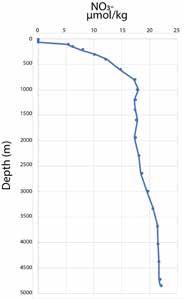
Credit: Chamberlin
Figure 10.53
Vertical profile of nitrate, a macronutrient, in the Atlantic. Data from World Ocean Circulation Experiment Cruise 32OC202/1, Station 50 via PTEO.
Figure 10.54
At the end of the day, biologically important nutrients provide the building blocks of some of the most intricate and beautiful life-forms on our planet, like this chain-forming spiral diatom.
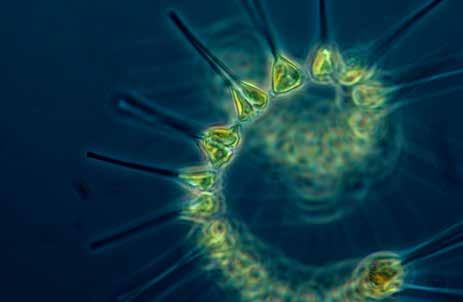
Credit: NOAA CC BY 2.0
ocean that otherwise should be very productive. Micronutrients also include organic nutrients, such as thiamine, biotin, and vitamin B12
Given their use by phytoplankton, biologically important nutrients tend to be depleted in the upper ocean, where sunlight drives photosynthesis. Conversely, they tend to be highest in the deepest and oldest waters that remain out of sunlight, where photosynthesis doesn't occur.
10.7.3 DOM and POM
Greek philosopher-scientist Aristotle (385–323 BCE) was the first to report the presence of fatty substances on the sea surface, evidence for the presence of organic matter—biologically produced, carboncontaining molecules. Organic matter in the ocean broadly divides into two types: dissolved organic matter (DOM) and particulate organic matter (POM).
Operationally, DOM includes anything that passes through a 0.2 micrometer filter (e.g., Libes 2009). Technically, that includes small microbes and viruses—which are not dissolved—but that’s why it’s called an operational definition. POM includes anything alive or once living. As
10.7 Seawater Constituents
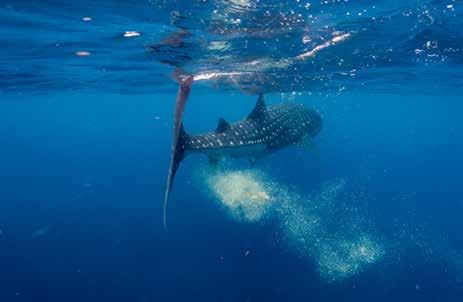
Credit: istock/Juan marcos borsatto
Figure 10.55
Organisms large and small produce poop, which disintegrates into particles (POM) and dissolved substances (DOM) in the ocean. Yes, this is a pooping whale shark.
expressed somewhat tongue-in-cheek by Pilson (2013), POM can be “collected with harpoons . . . hook and line . . . dragging a net . . . or filtering,” referring to the different sizes of living things—from blue whales to microbes—which make up POM.
DOM and POM mostly consist of carbon atoms. So oceanographers focus on measurements of dissolved organic carbon (DOC) or particulate organic carbon (POC) to estimate DOM or POM, respectively. By far, the greatest portion of organic matter in the ocean belongs to the DOC pool. Some 662 gigatons are reported (e.g., Hansell et al. 2009), slightly more than exists in terrestrial plants (e.g., Schlesinger and Barnhardt 2013).
Libes (2009) reports an estimated 55 gigatons of POC in the ocean, 50 gigatons of which is detritus—particles of dead organic matter (think finely ground leaf
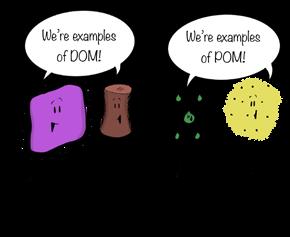
Credit: Shaw and Chamberlin
Figure 10.56
Different types of DOM and POM.
Figure 10.57
A
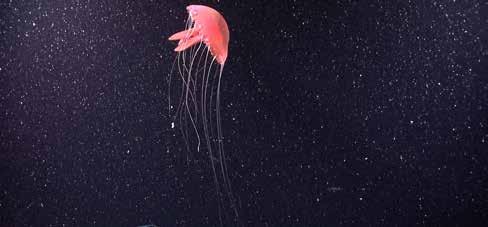
litter). Note that this amount includes everything you think of when you think of marine organisms.
Most of the biomass of the ocean can be found in the small things. Biomass-wise, the largest organisms, such as whales, represent only a tiny fraction of the ocean’s organic matter, around a tenth of a percent of the total POC (Smith 2007). Because DOM and POM play a significant role in primary productivity and marine food webs, we’ll defer our discussion of them until later chapters.
Figure 10.58
Dead whales represent the largest form of POM. An entire community of organisms (including octopus) is associated with whale falls. Everything is eaten, including the bones.
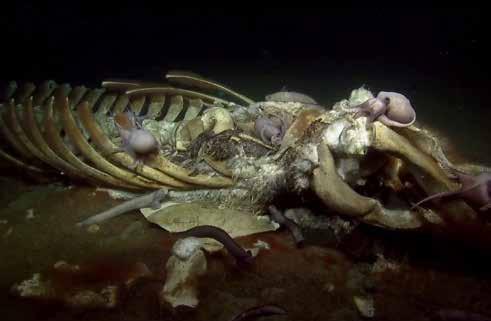
10.7 Seawater Constituents
10.7.4 Dissolved Gases
Have you ever shaken a can of soda and asked an unsuspecting person to open it for you? To their surprise and your amusement, the can erupts like a geyser, spraying soda everywhere.
Why do soft drinks fizz and froth when you open them after shaking? It’s because they contain a gas—carbon dioxide—that has been dissolved in the liquid (consisting of about 90 percent water and a combination of sugar, flavors, sodium, phosphorus, and other ingredients). Soft drink manufacturers pump carbon dioxide gas into the liquid at cold temperatures and high pressures, effectively trapping the gas in the container and creating a supersaturated solution. When that pressure is released—when the tab or cap is opened—the reduced pressure allows the gas to come out of solution.
Shaking the bottle or can ahead of time accelerates the process because shaking disrupts the arrangement of the water molecules holding the gas in place. As Live Science puts it, shaking releases dissolved gases into the space above the liquid, increasing its pressure (Choi 2022). Carbon dioxide also reacts chemically with water, a process that affects everything from lakes to coral reefs. In fact, increases in the atmospheric concentration of carbon dioxide are changing the chemistry of the ocean, as we shall see.
But first, let’s take a look at some fundamental properties of gases in seawater. Feel free to pop your own favorite beverage while reading this section.
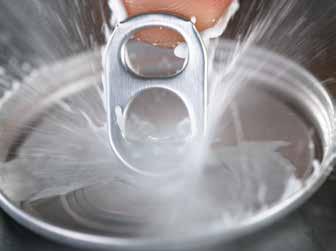
Credit: istock/Kesu01
Figure 10.59
Carbonated beverages—liquids pumped with carbon dioxide gas—generate sales of hundreds of billions of dollars annually.
10.7.4.1 Factors Affecting Dissolved Gases
Three main physical or chemical factors affect the dissolution of gases in seawater: temperature, salinity, and pressure:
1. The colder the water temperature, the greater the solubility of the gas.
2. The lower the salinity (the fresher the water), the greater the solubility of the gas.
3. The higher the pressure, the greater the solubility of the gas.
As the temperature of water decreases, the ability of the water to dissolve gases increases. Put another way, the solubility of gases increases with decreasing temperature. Conversely, as water temperature increases, less gas can be dissolved in a liquid. The solubility of gases decreases with increasing temperature. This relationship may seem at odds with what you learned previously about the solubility of solids in water. But the dissolution of gases in water works a bit differently from the dissolution of solids. Most gases (except for CO2) do not separate into their individual elements, like NaCl does. Instead, the water molecules surround the gas molecules, essentially trapping them in a net. At lower
Figure 10.60
As temperature increases, the solubility of CO2 in water decreases.
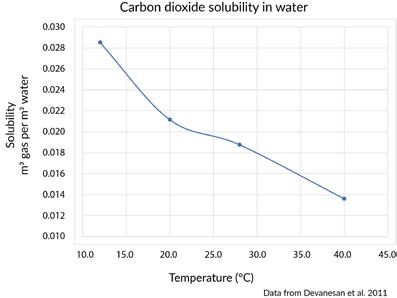
Credit: Chamberlin
10.7 Seawater Constituents

Credit: Shaw and Chamberlin
Figure 10.61
Water molecules act like a net to trap gases. Warmer temperatures increase the size of the "holes" in the net, allowing gases to escape.
temperatures the water molecules are closer together and form a tighter net, and gas molecules cannot escape as easily. At higher temperatures water molecules are spaced farther apart, so the “mesh” of the water net expands, allowing more gas molecules to escape.
Higher salinity reduces the solubility of gases. That means that freshwater holds a greater concentration of gases than saltwater. In effect the water net is more crowded in saltwater; Na and Cl take up space and reduce the capacity of water to surround gas molecules. In oceanic regions with higher salinity—regions with high rates of evaporation
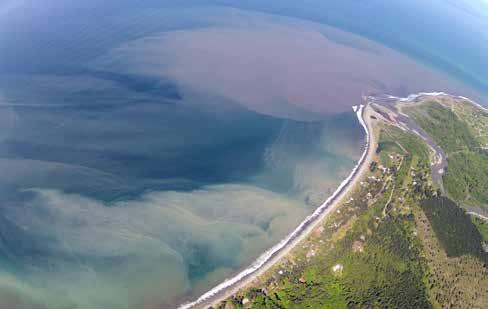
Credit: USGS/Tom Roorda
Figure 10.62
Lowered salinity may increase the solubility of gases. Here a plume of freshwater and sediment from the Elwha River flows into the Straits of Juan de Fuca near Port Angeles, Washington.
Figure 10.63
Polar oceans contain the highest concentration of dissolved gases. And if an ice diver has time to send birthday greetings to her mom, so do you!
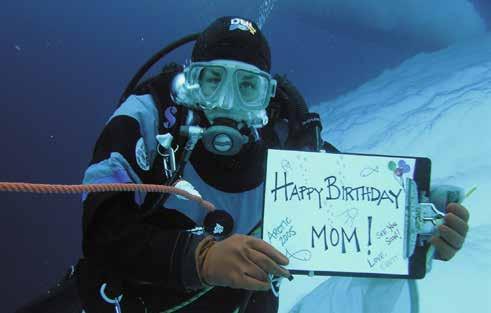
Credit: NOAA/OAR/OER CC BY 2.0
relative to precipitation or where sea ice forms, causing rejection of the seawater's salts—the saturation concentration of dissolved gases may be lower. In regions with lower salinity—regions with high rates of precipitation relative to evaporation, in estuaries, or near the mouths of rivers—the saturation concentration of dissolved gases may be higher. However, temperature may counteract salinity effects. Colder temperatures in polar oceans reduce the effects of higher salinity in these waters, and warmer temperatures in estuaries may act against any increase in solubility as a result of fresher water.
Pressure affects the solubility of gases in water, as we might expect from our soft drink example above: The higher the pressure, the greater the solubility of the gas. So, the deeper you descend in the ocean, the greater the solubility of gases in seawater. In fact, every 33 feet (10 m) increases solubility by about 10 percent. Thus, seawater at the surface (100% saturation) may become undersaturated with oxygen and other gases at depth. So at 33 feet (10 m), the saturation concentration of a gas drops to 90 percent. At the same time, pressure acts to capture bubbles of air that are swirled downward by breaking waves. As a result, surface waters of the ocean are often supersaturated with gases, just like a soft drink.
10.7 Seawater Constituents
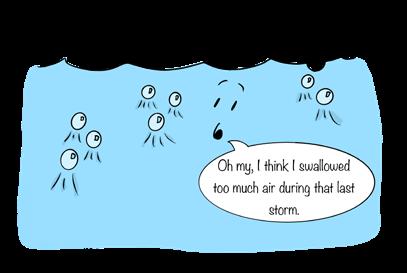
Credit: Shaw and Chamberlin
Molecular interactions help explain why oxygen dissolves in water.
Figure 10.64
Waves create bubbles of gas that become trapped in the water column and held beneath the surface by water pressure. Pressure increases gas solubility.
As polar water molecules approach, the oxygen molecule’s normally symmetrical electron cloud rearranges into an asymmetrical, weakly polar configuration—what is known as a dipole. As it does so, oxygen takes on the characteristics of a polar molecule. The positive and negative ends of the water molecule are now attracted to the negative and positive ends, respectively, of the oxygen dipole, and the oxygen molecule dissolves. Other nonpolar gases, like nitrogen, may also be dissolved in this way. Think of it as being like when you tell your parents your sibling made you do it. One molecule influences another molecule to do something it normally wouldn’t.

Credit: istock/ Maria Symchych-Navrotska
Figure 10.65
Molecules, like people, can be influenced to do something they wouldn't otherwise do. But it might take some persuading.
Figure 10.66
Strong winds, breaking waves, and turbulence inject gases from the atmosphere into the surface waters of the ocean.
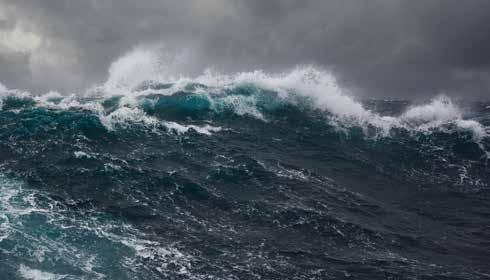
Credit: istock/andre67
10.7.4.2 The Air–Sea Interface
The boundary between the ocean and the atmosphere—where the sky and sea meet—is called the atmosphere–ocean interface, or simply the air–sea interface. It’s a part of the ocean that few have heard of, yet it just might be the most important feature of our planet. Engel et al. (2017) call it “the ocean’s vital skin,” the sea surface microlayer, the thin film of water no deeper than 1 millimeter (the width of a pinhead).
This interface acts as the gatekeeper for what enters the ocean from the atmosphere, and vice versa. A brief look at the role of this layer in gas exchange across the air–sea interface provides insights into the dynamic set of physical processes that control the concentration of dissolved substances in the ocean.
10.7.4.3 Gas Exchange
The simplest model of gas exchange across the air–sea interface (e.g., film theory; see Sarmiento and Gruber 2006; Liao and Wang 2013) assumes that transfer occurs as a result of simple diffusion—the movement of molecules across a boundary due to a concentration gradient (i.e., where the concentration of molecules across the
10.7 Seawater Constituents
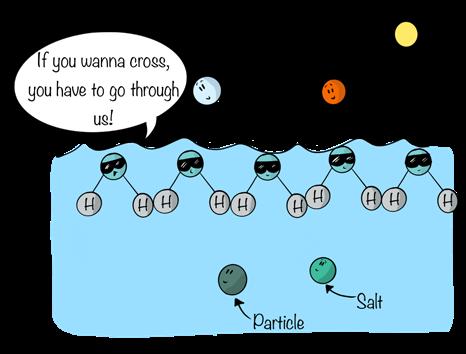
Credit: Shaw and Chamberlin
Figure 10.67
Arguably the most important boundary in the ocean, the sea surface microlayer controls the exchange of energy, gases, and particles across the air–sea interface. It also offers a unique habitat for marine microbes and larger marine organisms.
boundary differs). For example, a drop of food coloring in a glass of water diffuses throughout the glass until the same concentration of dye exists everywhere in the water. If diffusion was the only process controlling the exchange of gases across the air–sea interface, then the concentration of gases in the ocean would be directly proportional to their concentration in the atmosphere (according to a relationship known as Henry’s law). However, dissolved gases in the ocean, even near the surface, exhibit undersaturation or oversaturation relative to their atmospheric concentrations. In other words, most gases dissolved in the ocean are not in equilibrium with the atmosphere. That means other processes contribute to air–sea exchanges.
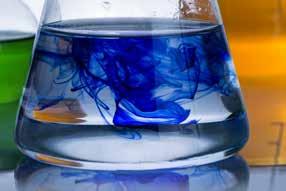
Credit: istock/L_Shtandel
Figure 10.68
Diffusion will cause a drop of dye in water to spread until the color is uniform.
10.69
Bubble injection by waves speeds the transfer of gases into and out of the ocean.
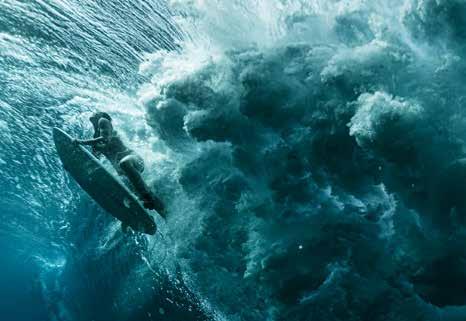
Anyone who has watched breaking waves at the shore or experienced them from beneath the surface as a swimmer or diver has likely noticed the effect of the waves on the water: They create foam, bubbles, and sea spray. Indeed, breaking waves in the open ocean also accelerate the exchange of gases across the air–sea interface. Waves break through the sea surface microlayer and allow gases to be transferred faster, both in and out of the atmosphere. Bubbles also penetrate the surface waters, where higher pressures compress and capture the gas molecules. The penetration and dissolution of bubbles of air caused by breaking waves is called bubble injection, a process that may lead to supersaturation.
Waves also contribute to turbulence in the upper ocean, the chaotic and irregular changes in the speed and direction of flowing water or air. Perhaps you’ve experienced turbulence in an aircraft or watched the turbulent chaotic spume of an incoming wave. Turbulence carries gases deeper and in more directions than simple diffusion. Bubble injection is an example of a turbulent process.
One way to think about turbulence is to consider the difference between pouring a dash of milk into a cup of coffee and letting it sit until
the milk is distributed throughout the coffee or stirring the coffee to homogenize the mixture. Turbulence acts like a stir stick that transfers heat, particles, gases, and a whole host of other things throughout the ocean.
10.7 Seawater Constituents

Credit: istock/FarKnot_Architect
10.7.4.4 Dissolved Gases in Ocean Research
Figure 10.70
Spoon-generated turbulence in your coffee makes the cream mix faster. Waves act like spoons in the ocean.
Research on seawater chemistry and dissolved gases in the ocean takes center stage for understanding a number of oceanographic processes, including the movements of water (e.g., using gases as tracers), the chemistry and biology of the seafloor (e.g., methane seeps), human impacts on marine life (e.g., dead zones), and ocean chemistry (e.g., ocean acidification, the increase of acidity in the ocean). Here we take a look at two gases: chlorofluorocarbons, used as tracers of water mass movements, and methane, a potential energy source and potent greenhouse gas. In later chapters we look more closely at research on
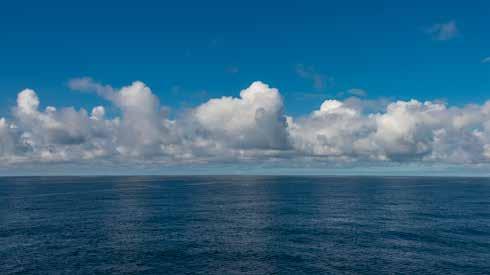
Credit: istock/Neurobite
Figure 10.71
With growing concerns about human-caused climate change, our understanding of the ocean's "vital skin" is as important as ever.
carbon dioxide and oxygen, as a full understanding of these gases requires a bit more knowledge of the physics and biology of the ocean.
Chlorofluorocarbons (pronounced klor-oh-FLOOR-oh-car-buns), also known as CFCs, represent a class of gas molecules containing chlorine and fluorine (i.e., halogens) used widely as refrigerants and propellants from the 1930s through the 1980s. When carried high into the atmosphere, these gases break apart and destroy ozone (O3), most of which is found in the ozone layer—a part of the stratosphere, which is the atmospheric layer above the one in which we live. Near the ground ozone can be harmful (“bad” ozone). In the stratosphere ozone absorbs DNA-damaging ultraviolet radiation (just like a good pair of sunglasses). So the ozone layer (“good” ozone) acts as a shield protecting life— including ocean life—from the harmful effects of ultraviolet radiation.
Figure 10.72
Meteorologists recognize five layers within Earth's atmosphere. The layer closest to the Earth—the troposphere— creates the weather we experience on Earth's surface.
Ozone in the stratosphere above the troposphere absorbs ultraviolet radiation, thereby protecting life on Earth.

The reduction of the ozone layer occurs mostly in polar regions (most notably Antarctica), where cold temperatures and other atmospheric conditions favor the ozone-destroying reactions. The net result has been an ozone hole, a region where stratospheric ozone concentrations are greatly reduced. Because CFCs destroy the ozone layer, they were banned in 1987 under an international treaty called the Montreal Credit: NOAA
10.7 Seawater Constituents
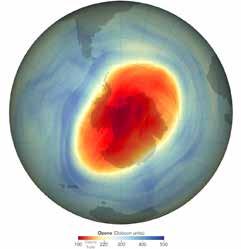
Credit: NASA
Protocol on Substances That Deplete the Ozone Layer. Former UN Secretary-General Kofi Annan (1938–2018) called this global effort “the single most successful international environmental agreement to date” (Annan 2000, p. 56). Unfortunately, CFCs and their byproducts (especially chlorine) can remain in the atmosphere for hundreds of years. Thus, while most CFCs have been completely phased out and are no longer released into the atmosphere, their long lifetimes mean that the ozone hole will remain with us for several more decades. In 2022, the ozone hole reached its smallest maximum extent in decades (Gillespie 2022). A report released by the World Meteorological Organization in 2022 highlighted that “actions taken under the Montreal Protocol continued to decrease atmospheric abundances of controlled ozone-depleting substances” (WMO 2022).
Despite their negative impacts, CFCs offer an opportunity to study and better understand deep ocean circulation. CFCs act as a kind of time stamp for the origin and movements of water in the ocean’s interior, a group of substances known as ocean tracers. When surface waters sink, the gases they contain are transported with them.

Credit: istock/Wavebreakmedia
Figure 10.73
On October 3, 2022, the Antarctic ozone hole shrank to its smallest extent in decades, a sign of progress in efforts to eliminate CFCs.
Figure 10.74
Surface intensities of harmful ultraviolet radiation increase when stratospheric ozone is reduced. Be sure to use sunscreen when spending time in the Sun.
Figure 10.75
Concentrations of CFC-12 across a section of the Atlantic Ocean. By following concentrations over time, oceanographers can infer water movements and mixing in the deep sea.
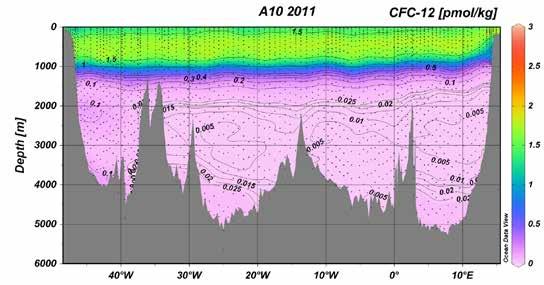
Credit: NOAA/Pacific Marine Environmental Laboratory
Because these waters are in contact with the atmosphere, the soon-tobe-deep water takes on the properties of the atmosphere. As a result, deep water masses record the composition of the atmosphere at the time of their sinking. Dissolved gases, other dissolved substances, particulate matter, and even temperature and salinity can act as tracers. These tracers allow oceanographers to figure out when a particular mass of water formed and how it mixed with other water masses as it moved. As the Water Encyclopedia (2023) puts it, “Tracers serve as a ‘dye’ with which to follow the circulation of ocean waters.”
The discovery of hydrothermal vents reinvigorated seafloor exploration and paved the way for the discovery of other chemosynthetic systems, such as cold seeps—places in the seafloor where methane and other energy-rich fluids leak through the sediments. Cold seeps provide an energy source for chemosynthetic ecosystems that is every bit as bizarre and wonderful as hydrothermal vents. In fact, some of these ecosystems may survive for hundreds—maybe even thousands—of years. There has been considerable speculation about the mining of the reserves of the methane associated with cold seeps. But the environmental consequences and wisdom of unleashing yet another carbon-emitting
energy source remain to be determined.
10.7 Seawater Constituents
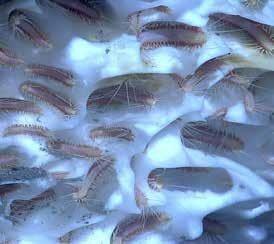
Figure 10.76
Methane (CH4), a little-heralded molecule composed of one carbon and four hydrogen atoms, exerts a tremendous influence on Earth’s atmosphere and plays an important role in food webs and carbon cycling in lakes and the ocean. In the atmosphere methane acts as a greenhouse gas, the second-most potent after carbon dioxide.
Cold seeps offer a source of methane hydrates and a home for ice worms. The Gulf of Mexico (shown here) is especially rich in these deposits.
Methane caught scientists by surprise when it was found in frozen form at the bottom of the ocean as methane hydrates, molecules of methane gas trapped in crystals of water ice that form at reduced temperatures and elevated pressures. Nearly all the methane and methane hydrates found in ocean sediments originate from the activities of methanogens, a type of microbe that converts organic matter into methane. Methanogens can be found in the water column and in sediments at the seabed surface (e.g., Max and Johnson 2016; Niu et al. 2018). Reeburgh (2007) estimates that methanogens living in seafloor sediments produce a billion tons of methane annually.
The primary interest in methane hydrates—though undoubtedly important in deep-sea ecology—lies with their vast potential as an
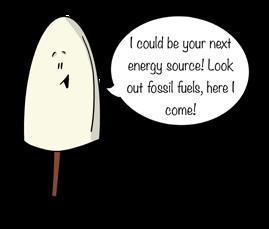
Figure 10.77
Seafloor methane hydrates offer enormous potential as an energy source.
Figure 10.78
Bubbles of methane, produced by methanogenic
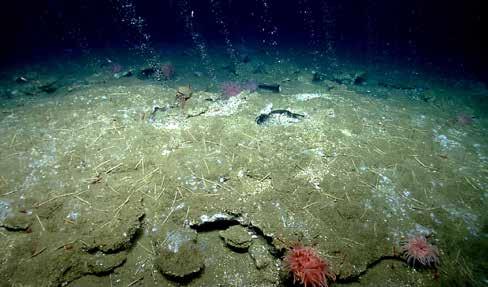
Credit: NOAA CC BY 2.0
energy source. Natural gas hydrate, or NGH, as it is known in the energy industry, represents potentially the largest reservoir of unconventional gas on our planet (Max 2018). Even if only 15 percent of the world’s reserves can be economically extracted, there is enough NGH on the seafloor to meet global energy needs for the next 200 years or longer (Max and Johnson 2016).
As of 2019, Japan and China have successfully extracted deep-sea methane in experimental test wells, but no technology currently exists for commercial extraction of NGH from the seabed. Nevertheless, given the vast reserves, the energy industry views NGH as a “bridge” energy source, one that will enable countries to make the transition from fossil fuels to renewable sources. As Max and Johnson (2016) put it:
A completely renewable energy future may be in our future, but its timing is very uncertain. . . . Natural gas is the clean hydrocarbon fuel that will reach into the renewable energy future. Its continued availability at affordable prices becomes increasingly important as coal and oil power plants are retired and energy demand becomes increasingly filled by development of renewable or intermittent power sources.
Clearly, oceanographers have a lot more to discover and learn about the ocean and its resources. It is a frontier ripe for exploration and adventure—and a lot closer to home than the moon or Mars.
10.8 Chapter References
10.8 Chapter References
Annan, Kofi A. 2000. “We the Peoples”: The Role of the United Nations in the 21st Century. New York: United Nations. https://digitallibrary. un.org/record/413745?ln=en
Baines, Stephen B., Benjamin S. Twining, Mark A. Brzezinski, Jeffrey W. Krause, Stefan Vogt, Dylan Assael, and Hannah McDaniel. 2012. “Significant Silicon Accumulation by Marine Picocyanobacteria.” Nature Geoscience 5: 886–891. https://doi.org/10.1038/ngeo1641
Bruland, K. W., and M. C. Lohan. 2006. “Controls of Trace Metals in Seawater.” In The Oceans and Marine Geochemistry, Treatise on Geochemistry, Vol. 6. Edited by H. Elderfield, 23–47. Oxford: Elsevier. https://www.elsevier.com/books/the-oceans-and-marinegeochemistry/elderfield/978-0-08-045101-5
Carrano, Carl J., Stephen Schellenberg, Shady A. Amin, David H. Green, and Fritjof C. Küpper. 2009. “Boron and Marine Life: A New Look at an Enigmatic Bioelement.” Marine Biotechnology 11: 431–440. https://doi. org/10.1007/s10126-009-9191-4
Chatt, J. 1979. “Recommendations for the Naming of Elements of Atomic Numbers Greater than 100.” Pure and Applied Chemistry 51: 381–384. https://doi.org/10.1351/pac197951020381
Choi, Charles Q. 2022. “Why Does Soda Fizz?” LiveScience. July 22, 2022. https://www.livescience.com/32492-why-does-soda-fizz.html
Dittmar, William. 1884. “Part I. Report on Researches into the Composition of Ocean-Water, collected by H.M.S. Challenger, during the years 1873-1876.” In Report on the scientific results of the voyage of H.M.S. Challenger during the years 1873-76. Physics and chemistry, Vol. 1. Edited by Thomson, C. Wyville, and John Murray. London: Order of Her Majesty’s Government. https://escholarship.org/uc/ item/38p2q583
Djeghri, Nicolas, Philippe Pondaven, Fabienne Le Grand, Antoine Bideau, Nolwenn Duquesne, Maria Stockemreiter, Stephan Behl, Jessica Y-T Huang, Thomas Hansen, Sharon Patris, Gerda Ucharm, and Herwig Stibor. 2021. “High Trophic Plasticity in the Mixotrophic Mastigias papua-Symbiodiniaceae Holobiont: Implications for the Ecology of Zooxanthellate Jellyfishes.” Marine Ecology Progress Series 666: 73–88. https://doi.org/10.3354/meps13707
Engel, Anja, Hermann W. Bange, Michael Cunliffe, Susannah M. Burrows, Gernot Friedrichs, Luisa Galgani, Hartmut Mermann, Norbert Hertkorn, Martin Johnson, Peter S. Liss, Patricia K. Quinn, Markus Schartau, Alexander Soloviev, Christian Stolle, Robert C. UpstillGoddard, Manuela van Pinxerton, and Birthe Zӓnker. 2017. “The Ocean’s Vital Skin: Toward an Integrated Understanding of the Sea Surface Microlayer.” Frontiers in Marine Science 4: 165. https://doi. org/10.3389/fmars.2017.00165
Falkowski, Paul G., Richard T. Barber, and Victor Smetacek. 1998. “Biogeochemical Controls and Feedbacks on Ocean Primary Production.” Science 281(5374): 200–206. https://doi.org/10.1126/ science.281.5374.200
Forchammer, Georg. 1865. “IV. On the composition of sea-water in the different parts of the ocean.” Philosophical Transactions of the Royal Society 155: 203–262. https://doi.org/10.1098/rstl.1865.0004
Gillespie, Alison. 2022. “Antarctic Ozone Hole Slightly Smaller in 2022.”
NOAA. October 26, 2022. https://www.noaa.gov/news-release/ antarctic-ozone-hole-slightly-smaller-in-2022
Hansell, Dennis A., Craig A. Carlson, Daniel J. Repeta, and Reiner Schlitzer. 2009. “Dissolved Organic Matter in the Ocean: A Controversy Stimulates New Insights.” Oceanography 22(4): 202–211. https://doi.org/10.5670/oceanog.2009.109
Ikeda, Takeshi. 2021. “Bacterial Biosilicification: A New Insight into the Global Silicon Cycle.” Bioscience, Biotechnology, and Biochemistry 85(6): 1324–1331. https://doi.org/10.1093/bbb/zbab069
Jeandel, Catherine, Michiel Rutgers van der Loeff, Phoebe J. Lam, Matthieu Roy-Barman, Robert M. Sherrell, Sven Kretschmer, Chris German, and Frank Dehairs. 2015. “What Did We Learn about Ocean Particles Dynamics in the GEOSECS-JGOFS Era?” Progress in Oceanography 133: 6–16. https://doi.org/10.1016/j.pocean.2014.12.018
Jones, Ian S. F. 2011. “Contrasting Micro- and Macro-Nutrient Nourishment of the Ocean.” Marine Ecology Progress Series 425: 281–296. https://doi.org/10.3354/meps08882
Liao, Qian, and Binbin Wang. 2013. “Near Surface Turbulence and Gas Exchange Across the Air-Sea Interface.” In Topics in Oceanography Edited by Enrico Zambianchi. London: Intertech. https://doi. org/10.5772/56415
Libes, Susan M. 2009. Introduction to Marine Biogeochemistry, 2nd ed. Burlington: Academic Press. https://www.elsevier.com/books/ introduction-to-marine-biogeochemistry/libes/978-0-12-088530-5
Max, Michael D., and Arthur H. Johnson. 2016. Exploration and Production of Oceanic Natural Gas Hydrate. Cham: Springer. https:// doi.org/10.1007/978-3-030-00401-9_1
Monterey Bay Aquarium Research Institute. 2023. “Periodic Table of Elements in the Ocean.” Accessed March 14, 2023. https://www.mbari. org/know-your-ocean/periodic-table-of-elements-in-the-ocean/ Moore, C. M., M. M. Mills, K. R. Arrigo, I. Berman-Franks, L. Bopp, P. W. Boyd, E. D. Galbraith, R. J. Geider, C. Guieu, S. L. Jaccard, T. D. Jickells, J. La Roche, T. M. Lenton, N. M. Mahowald, E. Marañón, I. Marinov, J. K. Moore, T. Nakatsuka, A. Oschlies, M. A. Saito, T. F. Thingstad, A. Tsuda, and O. Ulloa. 2013. “Processes and Patterns of Oceanic Nutrient Limitation.” Nature Geoscience 6: 701–710. https://doi.org/10.1038/ ngeo1765; Supplementary information
10.8 Chapter References
Niu, Mingyang, Wenyue Liang, and Fenping Wang. 2018. “Methane Biotransformation in the Ocean and Its Effects on Climate Change: A Review.” Science China Earth Sciences 61: 1697–1713. https://doi. org/10.1007/s11430-017-9299-4
Pilson, Michael E. Q. 2013. An Introduction to the Chemistry of the Sea. Cambridge: Cambridge University Press. https://doi.org/10.1017/ CBO9781139047203
Pytkowicz, Ricardo Marcos. 1962. “Effect of Gravity on Distribution of Salts in Sea Water.” Limnology and Oceanography 7(3): 434–435. https://doi.org/10.4319/lo.1962.7.3.0434
Reeburgh, William S. 2007. “Oceanic Methane Biogeochemistry.” Chemical Reviews 107(2): 486–513. https://doi.org/10.1021/cr050362v
Reynolds, Collin S. 2006. The Ecology of Phytoplankton. Cambridge: Cambridge University Press. https://doi.org/10.1017/ CBO9780511542145
Sarmiento, Jorge L., and Nicolas Gruber. 2006. Ocean Biogeochemical Dynamics. Princeton: Princeton University Press. https:// press.princeton.edu/books/hardcover/9780691017075/oceanbiogeochemical-dynamics
Scerri, Eric. 2013. “Cracks in the Periodic Table.” Scientific American. June 1, 2013. https://www.scientificamerican.com/article/cracks-inthe-periodic-table/
Schlesinger, William H., and Emily S. Bernhardt. 2012. Biogeochemistry: An Analysis of Global Change. 3rd ed. Waltham: Academic Press. https://www.elsevier.com/books/biogeochemistry/ schlesinger/978-0-12-385874-0
Scott, Alexander. 1887. “XVIII. On the Composition of Water by Volume.” Proceedings of the Royal Society of London 42(251–257): 396–400. https://doi.org/10.1098/rspl.1887.0090
Smith, Craig R. 2007. “Bigger Is Better: The Role of Whales as Detritus in Marine Ecosystems.” In Whales, Whaling, and Ocean Ecosystems. Edited by James A. Estes, Douglas P. Demaster, Daniel F. Doak, Terrie M. Williams, and Robert L. Brownell, Jr. 286–300. Berkeley: University of California Press. https://doi.org/10.1525/9780520933200-026
Statista. 2022. “Bottled Water—Worldwide.” March 2022. https://www. statista.com/outlook/cmo/non-alcoholic-drinks/bottled-water/ worldwide
Stats Medic. 2023. “Color Distribution for Various Types of M&Ms.”
Accessed January 18, 2023. https://www.statsmedic.com/m-mdistribution
Sutton, Jill, Michael J. Ellwood, William A. Maher, and Peter L. Croot. 2010. “Oceanic Distribution of Inorganic Germanium Relative to Silicon: Germanium Discrimination by Diatoms.” Global Biogeochemical Cycles 24(2): GB2017. https://doi.org/10.1029/2009GB003689
Twining, Benjamin S., and Stephen B. Baines. 2013. “The Trace Metal Composition of Marine Phytoplankton.” Annual Review of Marine Science 5: 191–215. https://doi.org/10.1146/annurevmarine-121211-172322
Wallace, William J. 1974. The Development of the Chlorinity/Salinity Concept in Oceanography. Amsterdam: Elsevier. https://www.google. com/books/edition/The_Development_of_the_Chlorinity_ salini/1RR7ngEACAAJ
Water Encyclopedia. 2023. “Tracers of Ocean-Water Masses.”
Water Encyclopedia. Accessed January 18, 2023. http://www. waterencyclopedia.com/St-Ts/Tracers-of-Ocean-Water-Masses.html
World Meteorological Organization (WMO). 2022. “Executive Summary.” Scientific Assessment of Ozone Depletion: 2022. GAW Report No. 278. Geneva: WMO. https://csl.noaa.gov/assessments/ozone/2022/
10.8 Chapter References
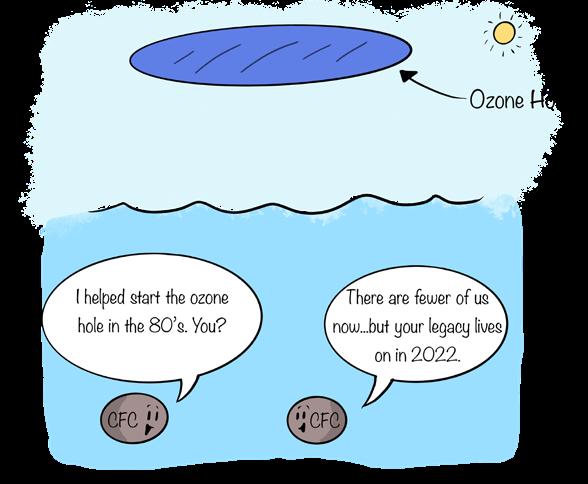
Figure 10.79
A reminder that what happens “there” doesn’t always stay there.
